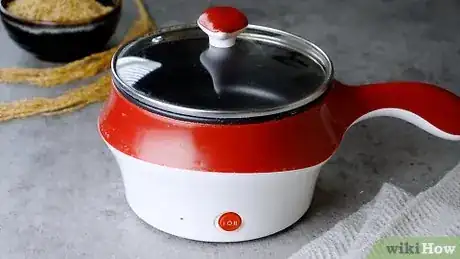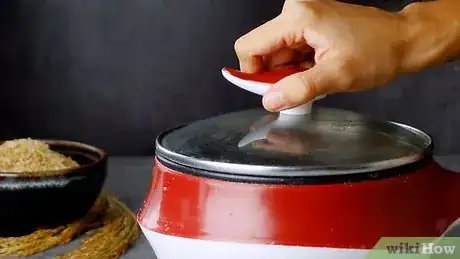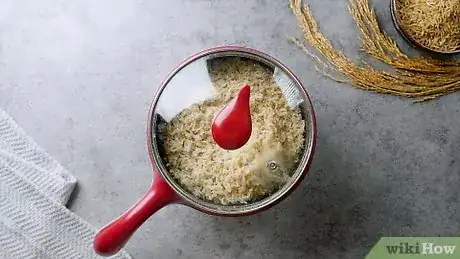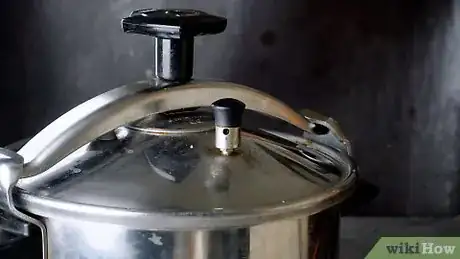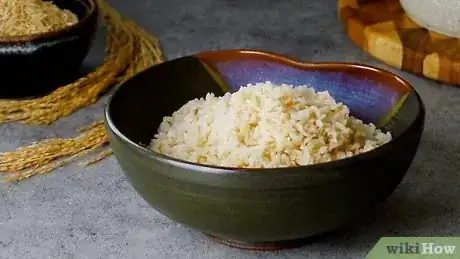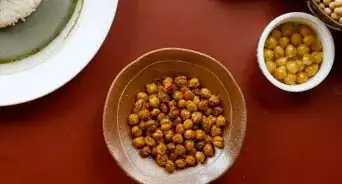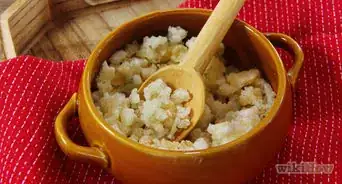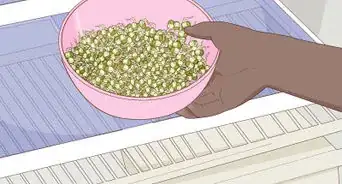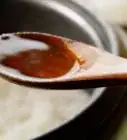This article was co-authored by JoAnna Minneci. JoAnna Minneci is a Professional Chef based in the Nashville, Tennessee area. With more than 18 years of experience, Chef JoAnna specializes in teaching others how to cook through private cooking lessons, team-building events, and wellness and nutrition classes. She has also appeared in numerous television shows on networks such as Bravo and Food Network. Chef JoAnna received Culinary Arts training from the Art Institute of California at Los Angeles. She is also certified in sanitation, nutrition, kitchen management, and cost control.
There are 17 references cited in this article, which can be found at the bottom of the page.
wikiHow marks an article as reader-approved once it receives enough positive feedback. In this case, several readers have written to tell us that this article was helpful to them, earning it our reader-approved status.
This article has been viewed 355,352 times.
Brown basmati rice is a delicious variety with a nutty flavor, and with the right tips, it can go from yummy to downright mouthwatering. Luckily, that's just what we'll offer you below! We're teaching you how to make expert-level brown rice dishes by boiling, pressure cooking, or a rice cooker. By the end of this article, you'll have all the tools you need to enjoy the healthy, aromatic brown rice meal of your dreams. Let's get started.
Ingredients
- 2 cups (470 ml) brown basmati rice
- 2.5 to 3 cups (590 to 710 ml) water
- 1 teaspoon (4.9 ml) salt
Servings: Makes 6 cups
Steps
Boiling Brown Basmati Rice
-
1Rinse the rice. Measure 2 cups (470 ml) brown basmati rice, and pour it into a medium-sized bowl of cold tap water. Use your hand to swish the rice around until the water becomes cloudy-looking and foam appears on the edges. Pour out the water through a mesh strainer or by tilting the bowl to the side. Add more cool tap water and repeat this process until the water is clear. This could require up to 10 rounds of washing the rice.[1]
- While rinsing can wash away some of the rice's nutrients, brown basmati rice is typically imported and may be processed with talc, powdered glucose, and rice powder. Rice connoisseurs, therefore, recommend rinsing it.
- Doing so will also get rid of some of the starch, which will help make your rice less gluey.[2]
-
2Combine the rinsed rice and cold water to soak. Add 2.5 cups (590 ml) cold water to the drained and rinsed rice and let it soak between 30 minutes to 24 hours depending upon the method of cooking and how long you want to cook it. The longer you allow it to soak, the less time it will take to cook. After the rice is done soaking, drain the water from it using a strainer.Advertisement
-
3Prepare the water and add salt. Add 2.5 cups (590 ml) water to a medium-sized cooking pot with a lid on the stovetop.
- In order for the rice to cook properly, make sure the lid has a tight seal so heat and steam aren't released. Next add about 1 teaspoon (5 ml) salt to the water. As with pasta, salt is used to bring out the natural flavor in rice so it won't taste bland. It's not used to make it taste salty.[5]
- Always make sure your pot isn't too small because the rice will triple in volume once cooked.
- Season the brown rice with other flavors if you want to go beyond just salt.[6]
-
4Mix the rice and water. Pour 2 cups (470 ml) rinsed and pre-soaked brown basmati rice to the pot and use a spoon to mix the rice with the water.[7]
-
5Bring it to a boil and then simmer. Turn the burner to high. Once the water comes to a boil, reduce the heat to low, cover, and simmer for 15-40 minutes until all the water is absorbed.[10] [11]
- The time difference is largely based on how long you soaked the rice.
- If you soaked it for 30 minutes, your cook time will be closer to 40 minutes. If you soaked it overnight, your cook time will be closer to 15 minutes.
- It's very important to turn down the heat and to simmer once the water boils. Rice that's cooked too fast on high heat will be hard because the water will evaporate. The kernels will also break.[12]
-
6Test to see if it's done. Quickly remove the lid and use a fork to scoop out some of the rice. Immediately replace the lid. If the rice is tender and the water has fully absorbed, it's ready. If not, continue cooking another 2-4 minutes.
- You may need to add more water if it's not tender but the water has been fully absorbed. Start slowly by adding just a 1⁄4 cup (60 ml) of water.
-
7Remove the pot from the burner and cover with a towel. When done, take the pot from the burner and remove the lid. Place a folded kitchen towel over the pot, and promptly replace the lid.[13]
- The towel will help to steam the rice, making it fluffier. It also absorbs extra moisture that would otherwise fall back onto the rice.[14]
-
8
-
9
-
10Scoop and serve. Use a large spoon or a nonstick rice paddle spoon to scoop out the rice. Serve it now alone or as part of another dish.
Cooking Brown Basmati Rice in a Rice Cooker
-
1Read the instructions carefully. There are a variety of rice cookers on the market, and they don’t all operate in the same way or have the same features.
- For instance, some will have both white and brown rice settings. Others won’t have either.
-
2Combine the water and rice. Use a wooden spoon or rice paddle spoon to mix 2 cups (470 ml) brown basmati rice and 3 cups (710 ml) of water into the inner pot of the rice cooker.
- Many rice cookers come with a dry measuring cup. However, they’re often only equivalent to 3/4 of a standard cup.
- Don’t use metal utensils when mixing or scooping because they can damage the non-stick coating of the inner pots.
-
3Put on the lid and turn it to cook. Generally, rice cookers have two settings – cook and warm – so make sure you select cook. This will bring the water to a boil very quickly.
- Once the rice has absorbed all the water, the temperature will rise past the boiling point of water (100˚C/212˚F). At this point, most rice cookers will then automatically switch to the warm setting.
- This will typically take about 30 minutes.
- The warm setting will hold the rice at a safe serving temperature until you turn off the cooker.
-
4Don’t take off the lid during cooking. As with the boiling method, don’t lift the lid while the rice is cooking or the water vapor needed to cook it will disperse.[19]
-
5Let the rice rest in the cooker. After it switches to warm, keep the lid closed and let the rice sit for 5-10 minutes to finish cooking.[20]
-
6Open the cooker and fluff the rice. Carefully open the lid away from your face to avoid being burned by any excess steam. Use a wooden or rice paddle spoon to gently fluff the rice. [21]
-
7Dish it out. You can serve it now or save it for later in the refrigerator or freezer.
- If refrigerating, put the rice into a bowl and cover with a lid or saran wrap. It should keep for 3-4 days. Don't leave it out for more than two hours before refrigerating.
- If freezing, rinse it in cool water, place portions in zip lock bags and place them in the freezer. Thaw the rice in the baggies overnight in the refrigerator.[22]
Pressure Cooking Brown Basmati Rice
-
1
-
2Secure the lid. Begin timing when the pressure cooker reaches high pressure.[25] [26]
- Various models will have different types of valves to alert you when the pressure cooker is at high pressure.
- Those with spring valves generally have a bar or rod that rises; jiggler valves will rock and jiggle slowly at first and then rapidly; weight-modified valves will whistle and hiss as they lift up and down.[27]
-
3Decrease the heat and continue cooking. Reduce the burner's temperature until the pressure cooker has stabilized and let the rice keep cooking.[28] The total time from reaching high pressure until you're done should be between 12-15 minutes.
-
4Turn off the heat. Allow the temperature and pressure to drop naturally for about 10-15 minutes after turning off the heat. The safety-locking mechanism will disengage or an indicator will alert you that the pressure has dropped.[31] [32]
- Alternatively, put on oven mitts and place the pressure cooker in the sink. Run cold water over it to decrease the pressure. Then remove the valve and push the button/twist/press the lever to release water vapor and any remaining pressure.[33] [34]
- Either way, be careful while doing this and know from where the vapor will shoot out so you aren't burned.[35] [36]
-
5Fluff the rice and serve. Use a fork to fluff the rice and serve now, or refrigerate or freeze for later use.
Community Q&A
-
QuestionIf your rice cooker has a brown rice setting which takes longer than white, do you still soak the basmati rice overnight to shorten the cooking time?
 afifaCommunity AnswerYes, soaking is necessary. You can reduce the soaking time to 2-4 hours. Then cook the brown rice in the rice cooker as per the settings.
afifaCommunity AnswerYes, soaking is necessary. You can reduce the soaking time to 2-4 hours. Then cook the brown rice in the rice cooker as per the settings. -
QuestionAfter soaking for 24 hours and draining the rice, can one then put soaked, drained rice into a sealed container in refrigerator (or cooler) for another 24 hours before cooking?
 afifaCommunity AnswerNo. It is always better to cook the rice immediately after soaking. In case you store the rice in fridge, the texture may be a bit hard and chewy.
afifaCommunity AnswerNo. It is always better to cook the rice immediately after soaking. In case you store the rice in fridge, the texture may be a bit hard and chewy. -
QuestionIs it really necessary to rinse brown basmati rice till clear?
 Emilia MeyerCommunity AnswerIt´s not necessary, but it will make it easier to digest, as it removes some of the starch.
Emilia MeyerCommunity AnswerIt´s not necessary, but it will make it easier to digest, as it removes some of the starch.
Things You’ll Need
Brown Basmati Rice:
- Medium-sized mixing bowl
- Medium-sized pot with a tight-sealing lid
- Dry and liquid measuring cups and spoons
- Large spoon
- Fork
- Kitchen towel
- Stovetop steamer
- Stovetop pressure cooker
- Oven mitts
- Nonstick rice paddle spoon (optional)
References
- ↑ http://www.washingtonpost.com/wp-dyn/content/article/2008/10/21/AR2008102102172.html
- ↑ http://www.chow.com/food-news/148823/nagging-question-should-you-rinse-rice-before-cooking/
- ↑ http://www.finecooking.com/item/13378/soaking-basmati-rice
- ↑ http://www.chow.com/food-news/148823/nagging-question-should-you-rinse-rice-before-cooking/
- ↑ http://www.marthastewart.com/924877/master-recipe-brown-rice
- ↑ https://food.unl.edu/fnh/cooking-brown-rice
- ↑ http://www.marthastewart.com/924877/master-recipe-brown-rice
- ↑ http://www.bonappetit.com/test-kitchen/common-mistakes/article/the-6-most-common-rice-cooking-mistakes
- ↑ https://food.unl.edu/fnh/cooking-brown-rice
- ↑ http://www.nytimes.com/2010/05/31/health/nutrition/31recipehealth.html?_r=0
- ↑ http://www.realsimple.com/food-recipes/browse-all-recipes/perfect-brown-basmati-rice
- ↑ http://www.bonappetit.com/test-kitchen/common-mistakes/article/the-6-most-common-rice-cooking-mistakes
- ↑ http://www.nytimes.com/2010/05/31/health/nutrition/31recipehealth.html?_r=0
- ↑ http://lifehacker.com/make-fluffier-rice-by-trapping-the-steam-with-a-kitchen-1686468378
- ↑ https://food.unl.edu/fnh/cooking-brown-rice
- ↑ http://www.nytimes.com/2010/05/31/health/nutrition/31recipehealth.html?_r=0
- ↑ http://www.nytimes.com/2010/05/31/health/nutrition/31recipehealth.html?_r=0
- ↑ http://www.realsimple.com/food-recipes/browse-all-recipes/perfect-brown-basmati-rice
- ↑ http://www.bhg.com/recipes/how-to/cooking-basics/how-to-cook-brown-rice/
- ↑ http://blog.williams-sonoma.com/how-to-cook-whole-grains-in-a-rice-cooker/
- ↑ http://www.food.com/recipe/aromatic-basmati-rice-rice-cooker-424415
- ↑ http://www.food.com/recipe/perfect-brown-rice-in-a-steamer-298971
- ↑ http://www.cookinglight.com/cooking-101/techniques/pressure-cooker-recipes/how-to-cook-brown-rice-pressure-cookers
- ↑ http://premeditatedleftovers.com/recipes-cooking-tips/how-to-make-rice-in-a-pressure-cooker-real-food-real-fast/
- ↑ http://www.cookinglight.com/cooking-101/techniques/pressure-cooker-recipes/how-to-cook-brown-rice-pressure-cookers
- ↑ http://www.vegancoach.com/pressure-cooking-dried-beans.html
- ↑ http://www.hippressurecooking.com/is-your-pressure-cooker-ready-to-cook-checklist/
- ↑ http://premeditatedleftovers.com/recipes-cooking-tips/how-to-make-rice-in-a-pressure-cooker-real-food-real-fast/
- ↑ http://www.cookinglight.com/cooking-101/techniques/pressure-cooker-recipes/how-to-cook-brown-rice-pressure-cookers
- ↑ http://www.vegancoach.com/pressure-cooking-dried-beans.html
- ↑ http://www.hippressurecooking.com/is-your-pressure-cooker-ready-to-cook-checklist/
- ↑ http://www.vegancoach.com/pressure-cooking-dried-beans.html
- ↑ http://premeditatedleftovers.com/recipes-cooking-tips/how-to-make-rice-in-a-pressure-cooker-real-food-real-fast/
- ↑ http://www.cookinglight.com/cooking-101/techniques/pressure-cooker-recipes/how-to-cook-brown-rice-pressure-cookers
- ↑ http://www.hippressurecooking.com/is-your-pressure-cooker-ready-to-cook-checklist/
- ↑ http://www.cookinglight.com/cooking-101/techniques/pressure-cooker-recipes/how-to-cook-brown-rice-pressure-cookers
About This Article
To cook basmati brown rice, rinse the rice thoroughly until the water runs clear. Put the rinsed rice in a large bowl, add cold water, and let it soak for 30 minutes to 24 hours. Next, add water and a pinch of salt to a large pot with a tight-fitting lid, pour in the pre-soaked rice, and bring the water to a boil. Then, reduce the heat to low and simmer the rice for 15-40 minutes until the water is absorbed. Let the rice sit for 10 minutes, fluff it with a fork, and enjoy! For tips on cooking brown basmati rice in a rice cooker, read on!

